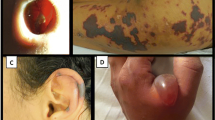Abstract
Ambiguous findings during external examination of a deceased in combination with dubious autopsy findings can raise doubts concerning the manner and cause of death. We report the case of a 35-year-old female deceased who had suffered from a borderline personality and depressive disorder with suicidal ideation. At the death scene, the body showed massive facial swelling accompanied by complete reddening of the skin of the face, with patchy skin abrasions on the forehead and neck, and purple bruise-like discolorations distributed symmetrically over both shoulders, elbows, hands, hips, knees, lower legs, and feet, raising the suspicion of underlying massive external blunt force injury. Police investigators strongly suspected sexual homicide. At autopsy, dissection in layers revealed massive subcutaneous hemorrhages as the cause of the reddish skin discolorations. Toxicological analyses showed fatal levels of lamotrigine with additional proof of zopiclone, zolpidem, diphenhydramine, O-desmethylvenlafaxine, pregabalin, tramadol, and modafinil in venous blood. Histologically, both the macroscopically impressive purple skin changes with underlying bleeding into the subcutaneous tissue and the skin abrasions were due to leukocytoclastic vasculitis, a form of acute hypersensitivity vasculitis that was a reaction to the multiple therapeutic drugs that the woman had taken shortly before death. The manner of death was classified as suicide, and sexual homicide was ruled out.



Similar content being viewed by others
References
Tattoli L, Tsokos M (2014) An unusual mechanism for patterned bruising in a fatal fall from a building. Forensic Sci Med Pathol 10:637–638
Tattoli L, Leonardi S, Carabellese F, Solarino B (2012) Acute lymphoblastic leukemia misdiagnosed as lethal child neglect. Rom J Leg Med 20:111–116
Asati DP, Singh S, Sharma VK, Tiwari S (2012) Dermatoses misdiagnosed as deliberate injuries. Med Sci Law 52:198–204
Chavali KH, Dasari H (2012) Dithranol: an unusual agent to produce artificial (false) bruise: a case report. Am J Forensic Med Pathol 33:253–255
Søndergaard Khinchi M, Nielsen KA, Dahl M, Wolf P (2008) Lamotrigine therapeutic thresholds. Seizure 17:391–395
Karimzadeh P, Bakrani V (2013) Antiepileptic drug-related adverse reactions and factors influencing these reactions. Iran J Child Neurol 7:25–29
Kaur S, Dogra A (2013) Toxic epidermal necrolysis due to concomitant use of lamotrigine and valproic acid. Indian J Dermatol 58:406
Sahin S, Comert A, Akin O, Ayalp S, Karsidag S (2008) Cutaneous drug eruptions by current antiepileptics: case reports and alternative treatment options. Clin Neuropharmacol 31:93–96
Ghislain PD, Roujeau JC (2002) Treatment of severe drug reactions: Stevens-Johnson syndrome, toxic epidermal necrolysis and hypersensitivity syndrome. Dermatol Online J 8:5
Mokhtari F, Nikyar Z, Naeini BA, Esfahani AA, Rahmani S (2014) Adverse cutaneous drug reactions: eight year assessment in hospitalized patients. J Res Med Sci 19:720–725
Blaho K, Merigian K, Winbery S (1995) Determining the true cause of death in a dermatological disaster. J Clin Forensic Med 2:205–211
Blyth DM, Markelz E, Okulicz JF (2012) Cutaneous leukocytoclastic vasculitis associated with levofloxacin therapy. Infect Dis Rep 4, e11
Henley JK, Blackmon JA, Fraga GR, Rajpara A, Maz M (2013) A case of glyburide-induced leukocytoclastic vasculitis. Dermatol Online J 19:19619
Pellicer-Oliver Z, Martin JM, Bella-Navarro R, Monteagudo C, Jordá E (2014) Leukocytoclastic vasculitis associated with sulfuric acid inhalation. Int J Dermatol 53:228–230
Hsu CY, Chen WS, Sung SH (2012) Warfarin-induced leukocytoclastic vasculitis: a case report and review of literature. Intern Med 51:601–606
Bachmann L, Dressler J, Pinzer T, Schackert G (1999) Human hypersensitivity angiitis: an uncommon cause of death after trauma. Langenbecks Arch Surg 384:200–203
Lasiæ D, Ivaniševiæ R, Uglešiæ B, Cvitanoviæ MZ, Gluèina D, Hlevnjak I (2012) Valproate-acid-induced cutaneous leukocytoclastic vasculitis. Psychiatr Danub 24:215–218
Won HK, Lee JW, Song WJ, Klaewsongkram J, Kang MG, Park HK, Lee HS, Kim MH, Chang YS, Cho SH, Min KU (2014) Lamotrigine-induced toxic epidermal necrolysis confirmed by in vitro granulysin and cytokine assays. Asia Pac Allergy 4:253–256
Timperman J, Verbauwhede W (1972) Toxic epidermal necrolysis (Lyell syndrome) and its medico-legal implications. Z Rechtsmed 71:139–144
Ventura F, Fracasso T, Leoncini A, Gentile R, de Stefano F (2010) Death caused by toxic epidermal necrolysis (Lyell syndrome). J Forensic Sci 55:839–841
Yi Y, Lee JH, Suh ES (2014) Toxic epidermal necrolysis induced by lamotrigine treatment in a child. Korean J Pediatr 57:153–156
French LK, McKeown NJ, Hendrickson RG (2011) Complete heart block and death following lamotrigine overdose. Clin Toxicol (Phila) 49:330–333
Amante MF, Filippini AV, Cejas N, Lendoire J, Imventarza O, Parisi C (2009) Dress syndrome and fulminant hepatic failure induced by lamotrigine. Ann Hepatol 28:75–77
Levine B, Jufer RA, Smialek JE (2000) Lamotrigine distribution in two postmortem cases. J Anal Toxicol 24:635–637
Conflict of interest
The authors declare that they have no competing interests.
Author information
Authors and Affiliations
Corresponding author
Rights and permissions
About this article
Cite this article
Tattoli, L., Krocker, K., Sautter, J. et al. Multidrug-related leukocytoclastic vasculitis raising suspicion of sexual homicide—things are not always what they seem. Int J Legal Med 130, 179–183 (2016). https://doi.org/10.1007/s00414-015-1202-6
Received:
Accepted:
Published:
Issue Date:
DOI: https://doi.org/10.1007/s00414-015-1202-6




